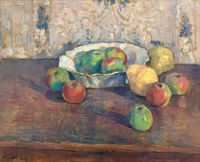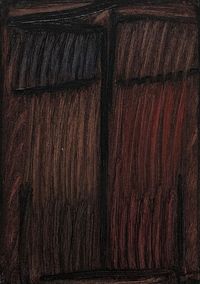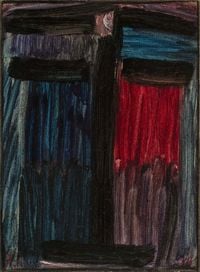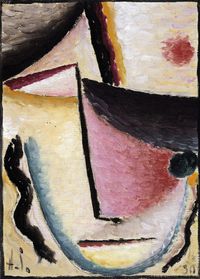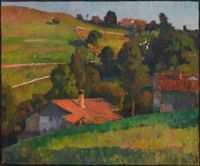A member of the influential art group Der Blaue Reiter, Russian émigré painter Alexej von Jawlensky was a leading portraitist among the early 20th-century German Expressionists. His colourful abstractions have led some to call him 'the Russian Matisse'.
Read MoreBorn to a Russian noble family in Torzhok, near Moscow, Jawlensky was obligated to pursue a military career early in life, entering the military academy in Moscow at 18. However, he spent his spare time examining paintings and drawings at Moscow's Tretyakov Gallery.
Garrisoned in culturally vibrant St. Petersburg, Jawlensky attended the Imperial Academy of Fine Arts, where he became skilled in traditional oil painting and drawing under the tutelage of Russian realist Ilya Repin. Meeting fellow artist and noble Marianne von Werefkin in 1896, who became an influential figure throughout the artist's life, Jawlensky was encouraged to leave the military altogether to pursue a fine arts career. That year, he departed for Germany with Werefkin and future wife Helene Nesnakomoff, among other aspiring Russian modernists.
Studying under Anton Ažbe in Munich, Jawlensky met Wassily Kandinsky, a long-standing compatriot and artistic influence. A trip to Paris in 1905 provided further inspiration from the works of Vincent van Gogh, Paul Gaugin, the Fauves, and particularly Henri Matisse, whom Jawlensky exhibited alongside.
In 1909, Jawlensky co-founded the Neue Künstlervereinigung München (NKVM) with Kandinsky and others. It was a precursor to Der Blaue Reiter (The Blue Rider), a group led by Kandinsky that Jawlenksy joined in 1912. Jawlenksy's other compatriots in the Munich years included Werefkin, Paul Klee, Franz Marc, August Macke, and Albert Bloch, among others.
Alexej von Jawlensky's portraits, landscapes, and still lifes are characterised by vivid colour schemes, expressive brush strokes, and an increasingly abstracted approach to form.
From around 1910, Jawlensky began to paint his first set of 'Head Paintings', a dominant format that he developed and altered throughout his career. Mostly featuring women—and believed by some to be a continuation of Russian Orthodox icon painting traditions—these were close-up, intimate portraits of friends and acquaintances.
Initially, these paintings depicted women in wide-brimmed hats, such Young Girl with a Flowered Hat (1910). Over time, influenced by Modernist currents, Jawlensky stripped the portraits of such details to focus on the form of the head. In Head of a Woman (1911), flat areas of rich colour are contained by black contours, and facial features are explored in daring contrasts and harmonies of colour. These harmonies became richer when Jawlenksy joined Der Blaue Reiter, as seen in the bold reds and greens in Mme. Turandot (1912).
Both Der Blaue Reiter, split up by the outbreak of war in 1914, and Jawlensky as a Russian national were soon exiled from Germany for the duration of the First World War. Cloistered in Saint-Prex, Switzerland without a studio, the artist made an extensive series of 'Variations', representing the view from his bedroom window.
More complex and abstract than earlier landscape paintings, Jawlensky's 'Variations' pared reality down into cones, circles, ovals, lines, planes, and dots. Colours depended on the season, weather, and the artist's personal disposition. Reflecting on these works, Jawlenksy said, 'every day I painted these colourful variations, always inspired by the atmosphere of nature at the time, paired with my spirit.' Jawlensky focused almost exclusively on this motif until 1917. He continued to paint 'Variations' from memory until 1921.
In 1917, taking this meditative mood with him to Zurich, Jawlensky met artists such as Hans Arp, Sophie Taeuber-Arp, Wilhelm Lehmbruck, and Arthur Segal. Frequenting the circles of Café Odéon, he also met the likes of Hugo Ball, Emmy Hennings, Hans Richter, and Tristan Tzara.
At this time, Jawlensky produced a series of 'Mystical Heads'. These employed a more simplified visual language, often expressively imbued with a sense of spiritual calm and quiet meditation. This was followed by a series of 'Saviour's Faces' (1918—1920), which carried deeply religious sentiments.
Further developing his seminal style, Jawlensky made over 300 'Abstract Heads', also known as 'Constructivist Heads', between 1918 and 1934. These are notable for their increased abstraction of the face into simple forms.
Jawlensky developed a visual canon that he applied ritualistically across these works. The head is shown strictly face-on, bordered by a U shape or tilted U with only a few lines for facial features, and featuring a few coloured dots to hold together the various colour compositions of the face. Part of the universal spiritualism underpinning these works, the eyes were always closed, intimating a state of inner meditation.
Post-war, Kandinsky, Jawlensky, Klee, and Lyonel Feininger reunited as Die Blaue Vier (the Blue Four) to promote their works in Mexico and America. From 1929, crippling arthritis increasingly restricted Jawlensky's art making. Becoming paralysed by illness, the artist would live long enough to see his paintings in Germany seized as part of Hitler's purge of Modern art and exhibited in the infamous Degenerate Art Exhibition of 1937. He passed away in 1941.
Alexej von Jawlensky has been the subject of both solo exhibition and group exhibitions internationally. His work also featured in the 1920 Venice Biennale.
Solo exhibitions include Everything! 100 years of Jawlensky in Wiesbaden, Museum Wiesbaden, Germany (2021); Alexej von Jawlensky: Face, Landscape, Still Life, Kunstmuseum Bonn, Germany (2012); Alexej von Jawlensky: Expressionism And Devotion, Kunstmuseum Den Haag, the Hague (2018); Alexei Jawlensky, Neue Galerie, New York (2017); Alexej von Jawlensky: Magische Bilder, Kunsthalle Krems, Austria (2003); Alexej von Jawlensky, Museu Picasso, Barcelona (1992); Alexej von Jawlensky, Kunstverein, Frankfurt (1967); Alexei Jawlensky: a Centennial Exhibition, Pasadena Art Museum (1964).
Group exhibitions include Les Aventuriers De L'art Moderne, Helene Bailly Gallery, Paris (2022); Alexej von Jawlensky and Marianne von Werefkin: Soulmates, Museum Wiesbaden, Germany (2020); Alexei and Andreas Jawlensky: Color Adventures, The State Russian Museum, St. Petersburg (2018); Gauguin to Picasso, The Phillips Collection, Washington, D.C. (2015); Klee and Jawlensky: An Artist's Friendship, Zentrum Paul Klee, Bern (2013); The Blue Rider, Albertina Museum, Vienna (2011); Degenerate Art: The Fate of the Avant-Garde in Nazi Germany, Los Angeles County Museum of Art (LACMA) (1991); The "Wild Beasts": Fauvism and Its Affinities, Museum of Modern Art, New York (1976); Turnus 1909—1910, Moderne Galerie Heinrich Thannhauser, Munich (1909).
Highly sought after among buyers of early 20th-century art, Jawlensky's artworks for sale at auction can fetch prices in the high millions. In 2011 Frau mit grünem Fächer (Woman with a Green Fan) (1912) sold for over US $11 million at Sotheby's. In 2008, Schokko mit Tellerhut (Schokko with Wide-Brimmed Hat) (1910) sold for $18.6 million at a Sotheby's auction, more than doubling its previous sale price in 2003.
The official Alexej von Jawlensky archive website can be found here.
Michael Irwin | Ocula | 2022
